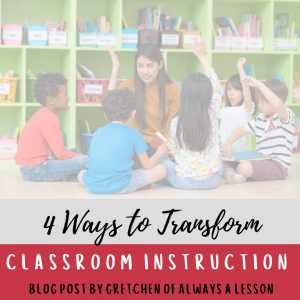4 Ways to Transform Classroom Instruction
It’s time we start the conversation about how to transform classroom instruction. The pandemic has shaken up the very old and outdated structure of classroom instruction. As we begin to rebuild our new normal, we need to take inventory of what works best for kids and what we need to reimagine.
I was recently reading about four shifts needed in education to have a bigger impact on student achievement. Each shift builds off the previous one, leading to transformational change in the classroom. I wholeheartedly agree with these four shifts and wanted to share them with you.
We need to push kids to deeper levels of thinking. This means spending time building their critical thinking and analysis skills. It is still imperative to reference Bloom’s Taxonomy when designing a lesson and line of questioning. However, we can’t continue to have the bulk of the lesson remain at lower levels of Bloom. We must help students develop a new habit of thinking at deeper levels. This takes significant practice, support and encouragement. Teachers must design lessons knowing the end goal is to operate at the deepest of levels for longer periods of time. When students become deeper thinkers, they better understand concepts from a variety of angles. Then, are able to transition through sequence of topics seamlessly, therefore, achieve at higher rates.
Teacher leaders can help teachers by reviewing lesson plans for deeper thinking and learning, record higher level questioning and activities during observations, and provide high quality professional development on creating lessons that move authentically through Bloom’s Taxonomy.
It’s important to note that the goal is not to race a lesson towards deep thinking if students aren’t ready. That leads to frustration and decreases student motivation. Instead, design each lesson to push student thinking deeper so that overtime the majority of the lesson is spent in the higher realms of Bloom.
Authentic Work
It’s no secret that creating multiple lessons a day for students takes a long time for a teacher to prepare. However, utilizing numerous worksheets to demonstrate student learning is not pushing student thinking to deep levels and doesn’t accurately evaluate their levels of learning.
Creating opportunities for students to demonstrate their learning through authentic work is necessary. This means less busy work and more unique assignments. It most likely will require students longer periods of time to create, but the outcome will be a stronger depiction of how well a student understands a particular concept. For example, instead of completing a page full of math word problems, students could be given a scenario to solve using the same math skills. [bctt tweet=”It’s best to go deep with less than wide with more.” username=”gschultek”] This means guiding student thinking deeper with skills on one problem than shallow thinking on multiple problems. When teachers provide flexibility in how students complete their work, student engagement and critical thinking is high.
Teacher leaders can help teachers design authentic work opportunities by modeling, sharing examples, and using professional learning communities [PLC’s] to create varied student outcome options. Authentic work takes longer to create for both students and the teacher. Knowing this, lesson pacing should be adjusted and teachers should begin the design process ahead of time. For example, teacher leaders can provide quarterly planning days where teachers design authentic work opportunities for assessments and assignments for the upcoming quarter.
Student Agency and Personalization
The flexibility teachers build in to student work options makes room for student agency- voice and choice in how to demonstrate learning. This means students have the opportunity to decide how they want to show what they know. It also means teachers know their students well to be able to offer options that meet their needs (ie. personality, learning style, interests, etc.). When students can use their strengths in the classroom they are more motivated to go above and beyond the requirements to showcase their knowledge.
Teacher leaders can help by analyzing student work with teachers, paying attention to which assignments students gravitated towards and which ones demonstrated student knowledge the strongest. This analysis will help teachers become better designers of learning opportunities and prompt additional conversations with students to get to know them better. A student learning survey is a great way to collect intel. (Get parents involved too by allowing them to share insights on their child through a letter of recommendation to the teacher!)
Technology
It’s important that teachers move away from implementing technology just to get credit for using it. Instead of randomly picking a tech device or tool, teachers should strategically choose their instructional instruments. [bctt tweet=”If technology does not enhance learning, it doesn’t need to be used.” username=”gschultek”] For example, if teachers are using a Smart Board only as a white board or are having students complete worksheets on an iPad, tech doesn’t need to be used. Technology should be used when it does something the teacher cannot do alone or that without it’s incorporation into a lesson, students won’t fully understand a topic.
Teacher leaders can help teachers select appropriate tech tools that align and properly assess learning objectives. They can host a tech festival where teachers can get exposed to a variety of tech tools, play with a variety of options to see the capabilities, and have time to choose a few to incorporate into future lessons. Teacher leaders should consistently support teachers in their tech choices to ensure it is enhancing student learning.
Each of these four shifts build on one another resulting in enhanced student learning. Teachers who provide personalized learning opportunities to students and incorporate technology that enhances learning creates an environment where students are thinking at deeper levels and producing authentic work. This is how you transform classroom instruction.
Are you in need of some support for enhancing student learning at your school? Grab these resources below:
- Instructional Best Practice Guides
- Leading Impactful PD Sessions Guide
- Unlock Teacher Potential Leadership Guides
Get access to more instructional coaching resources and professional development resources below:
GO BE GREAT!
How will you incorporate these four shifts into classrooms?




